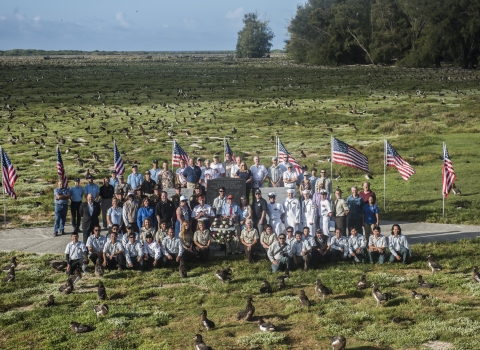If successful, a new outplanting of Umtanum desert buckwheat may become only the second population of the plant in the world.
When the entire population of a species only exists in a single location, it is a risky proposition. Catastrophic events like wildfire or drought can pose an outsized danger, perhaps jeopardizing the very existence of the species itself. One rare plant in central Washington that finds itself in such a situation, however, is being given a renewed shot at survival.
A team lead by the U.S. Fish & Wildlife Service has attempted to establish a second population of Umtanum desert buckwheat (Eriogonum codium), a plant listed under the Endangered Species Act that currently only exists naturally on one windswept ridge within Hanford Reach National Monument. Agency partners recently planted 264 precious seedlings of the threatened species on protected land at Cowiche Canyon Conservancy near Yakima. If these young plants survive and reproduce at that new location, it would be only the second population of the species on Earth.
“By having a second population, it provides some assurance that if disaster strikes in the form of wildfire or invasive species invasive species
An invasive species is any plant or animal that has spread or been introduced into a new area where they are, or could, cause harm to the environment, economy, or human, animal, or plant health. Their unwelcome presence can destroy ecosystems and cost millions of dollars.
Learn more about invasive species , the species as a whole may still persist,” said Tara Callaway, Washington State Recovery Coordinator for the U.S. Fish and Wildlife Service
The current population of Umtanum desert buckwheat consists of only about 3,000 plants in a narrow band several hundred feet long. The yellow-flowering plant is long-lived, perhaps living for up to a century, but the single population is small and declining. The seedlings that were recently planted were not extracted from that critical group, but rather grown in a nursery under the watchful eye of Wendy Gibble at the University of Washington Botanic Gardens Rare Care Program and at a local garden by a volunteer, Jane Abel.
The time spent in a nursery seems to give the young plants a boost. “Plants that are grown in a nursery for six months or more often have a better chance at survival than small seedlings when they are planted out at a site. While this is more labor intensive than directly sowing seeds at the site, it is an important tool to use when we have insufficient seeds available or seedling germination and establishment in the wild is poor,” explains Gibble.
The location of the new outplanting is on land owned by the Cowiche Canyon Conservancy, whose mission is to protect shrub-steppe and connect people to this vanishing landscape. “It gives me hope to see people coming together to care for the land and prevent the loss of a native species,” says Megan Whiteside, Conservation Projects Manager for the organization. “I think people are sometimes surprised to learn just how much diversity of life can be found in a healthy shrub steppe community. If we let pieces of that complex puzzle quietly go extinct, we do a disservice to the land and to ourselves”
Only time will tell if the new seedlings will establish and survive on their own. Past outplanting efforts for the species have faced significant challenges, as the species has proven to be quite particular about its habitat. Hopes are high, however, that this time the endeavor will help preserve this small piece of Washington’s natural heritage.
Partners involved in the outplanting included the U.S. Fish & Wildlife Service, the Cowiche Canyon Conservancy, University of Washington Botanic Gardens Rare Care Program, the Bureau of Land Management, and amazing volunteers.





